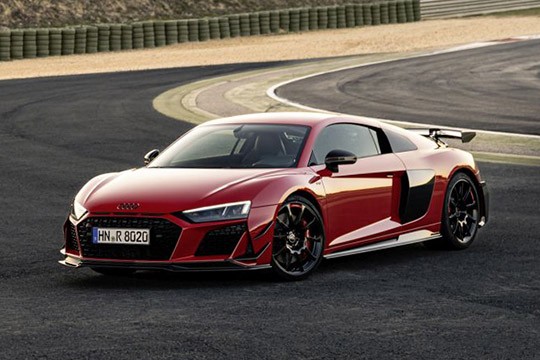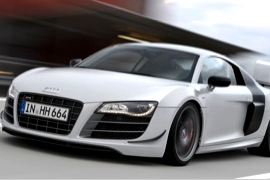AUDI R8 GT Models/Series Timeline, Specifications & Photos
First production year: 2010
Engines: Gasoline
Body style: Coupé (two-door)
The 2022 R8 V10 GT RWD was the swan song for Audi's first true supercar, and the carmaker said it would build it in just 333 units before giving it the axe.
When Audi unveiled the first generation of the R8 in 2006, it stunned the world because it was deemed the easiest-to-drive and control supercar in the world. But customers complained that the 4.2-liter naturally aspirated V8 was close but no cigar. It wasn't exactly in the same league as the Italian supercars. But then, the German carmaker introduced the 5.2-liter powerplant and replaced the sluggish automated gearbox with one disc with a dual-clutch one, and everything changed. Its all-wheel-drive system and comfortable cabin transformed the R8 into a genuine daily driver supercar. Then, in 2015, Audi scrapped the V8 from the list and left the car as a V10 affair only. After several special editions, the automaker understood that its customers loved the rear-wheel-drive versions, and that's why the last limited edition featured such a system. But it was more than just a regular R8 V10 with traction on two wheels.
At the front, the car featured a more aggressive bumper with a wider carbon fiber splitter at the lower side. On the bumper's corners, the automaker added double winglets to increase the downforce on the front axle. Furthermore, the massive singleframe grille sported a piano-black finish, and Audi used the same shade for the side scoops that grabbed air and cooled the front rotors. As a final detail, the automaker added three slats above the grille, resembling those installed on the Audi Ur-Quattro, the car that dominated the rally world at the beginning of the '80s.
From its profile, the R8 V10 GT RWD boasted 20-inch light alloy wheels wrapped in Michelin high-performance tires. The V10 logos on the front fenders were glossy black, like any other emblems found on the car, including the four-ring badge on the hood and rear fascia. Out back, the automaker installed a swan-neck wing carried over from GT3 cars that doubled the downforce on the rear axle compared to a regular R8 V10 quattro. Last but not least, a broad grille stretched from one side to the other of the rear fascia, like on the Ur-Quattro, while the biggest diffuser installed in a production vehicle was added under the bumper, flanked by a pair of big round exhausts.
Inside, Audi installed a pair of slim sports seats that provided a considerable amount of side support to their occupants. Fronting the driver was an Alcantara-wrapped steering wheel with a 12-o'clock mark and several knobs and switches, including the start-stop button. The automaker offered customers the option to have the vehicle's production number either added on an aluminum plate on the center console or engraved in a carbon-fiber trim.
Under its skin, the R8 V10 GT AWD featured the same 5.2-liter V10 powerplant as the rest of the R8 range but tuned to provide 610 PS (602 hp). In addition, the automaker improved the seven-speed automatic (dual-clutch) gearbox for faster shifts and altered the gear ratios compared to the R8 V10 Performance. It allowed customers to select the level of drift angles in seven steps, where the lowest one barely allowed the back end to kick out, while the seventh level allowed for more wheelspin. To stop the supercar, Audi installed big ceramic brakes as standard.
Audi listened to its customers, and in 2010, it produced the R8 GT as a track-oriented supercar that could be driven there and back home on its wheels without the need for a trailer.
Creating a car that could handle well on a track and on regular streets was challenging for Audi. The last time it did that was with a rally car, and that was a completely different game. This time, it had to take the R8, make it lighter, faster, and more powerful, and still be able to be driven comfortably on regular streets. Luckily, the German automaker had vast experience in the racing industry. As a result, it used specific technologies and materials to shave around 100 kilograms (220 lbs.) from the regular R8 V10 weight. Furthermore, it re-tuned the engine for some extra oomph and the suspension for race track activities. Last but not least, it produced the car in just 333 units, and there were only four colors available for it. Obviously, all of them sold like hotcakes.
The car’s front featured some upgrades compared to the standard R8 V10. Audi installed a black singleframe grille that was flanked by matt gray side scoops that cooled the front discs. In addition, the automaker added carbon fiber winglets on the bumper’s corners and a double spoiler underneath the apron.
From its profile, the striking look of the carbon-fiber door mirror caps and the panel behind the doors told bystanders that this was not a regular R8. Proof of that was the GT badges that adorned the front fenders instead of the V10 badges from its heavier sibling. Behind the cabin, on the deck, Audi installed a fixed wing that replaced the retractable one from the rest of the R8 Coupe range. This solution created an even better supercar aspect for the R8 and also helped lower the car’s overall weight since the motors that raised or lowered the spoiler were no longer needed and installed. Another R8 GT-specific detail was for the exhausts, which were round instead of ovals like on the R8 V10.
Inside, the carmaker had to make some tough decisions. One of the most important was to replace the regular, comfortable sports seats from the regular R8 and install new ones. These carbon-fiber sports seats with integrated headrests allowed a six-point harness installation. In addition, by replacing the regular seats with these ones, Audi saved about 31 kilograms (66 lbs.). In addition, the carmaker replaced the windshield and the rest of the windows with polycarbonate, further reducing the overall weight of the R8 GT. But still, customers could enjoy driving the car on public roads since this track-oriented vehicle came fitted with an MMI infotainment system, power windows and locks, and air conditioning.
The beating heart of the R8 GT was a 5.2-liter V10 gasoline engine. It was related to the one installed on the Lamborghini Gallardo. In this version, it produced 560 PS (553 hp) instead of 525 PS (518 hp) provided by the regular R8 V10. Power went in all corners via either a six-speed manual or a six-speed automated (single-clutch).

